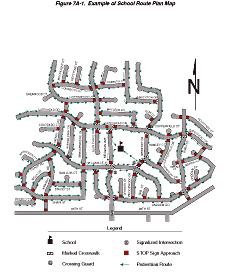Chapter 7A. General
Section 7A.01 Need for Standards
Support:
It is important to stress that regardless of the school location,
the best way to achieve reasonably safe and effective traffic control
is through the uniform application of realistic policies, practices,
and standards developed through engineering judgment.
Pedestrian safety depends upon public understanding of accepted methods for efficient traffic control. This principle is especially important in the control of pedestrians, bicycles, and other vehicles in the vicinity of schools. Neither pedestrians on their way to or from school nor road users can be expected to move safely in school areas unless they understand both the need for traffic controls and how these controls function for their benefit.
Procedures and devices that are not uniform might cause confusion among pedestrians and road users, prompt wrong decisions, and contribute to crashes. To achieve uniformity of traffic control in school areas, comparable traffic situations need to be treated in a consistent manner. Each traffic control device and control method described in Part 7 fulfills a specific function related to specific traffic conditions.
A uniform approach to school area traffic controls assures the use of similar controls for similar situations (which promotes uniform behavior on the part of motorists, pedestrians, and bicyclists).
A school traffic control plan permits the orderly review of school area traffic control needs, and the coordination of school/pedestrian safety education and engineering activities.
Guidance:
A school route plan for each school serving elementary to high school
students should be prepared in order to develop uniformity in the
use of school area traffic controls and to serve as the basis for
a school traffic control plan for each school.
The school route plan, developed in a systematic manner by the school, law enforcement, and traffic officials responsible for school pedestrian safety, should consist of a map (see Figure 7A-1) showing streets, the school, existing traffic controls, established school walk routes, and established school crossings.
Figure 7A-1 Example of School Route Plan Map

The type(s) of school area traffic control devices used, either warning or regulatory, should be related to the volume and speed of vehicular traffic, street width, and the number and age of the students using the crossing.
School area traffic control devices should be included in a school traffic control plan.
Support:
Reduced speed limit signs for school areas and crossings are included
in this Manual solely for the purpose of standardizing signing for
these zones and not as an endorsement of mandatory reduced speed
zones.
Section 7A.02 School Routes and Established School Crossings
Support:
The planning criterion for school walk routes might make it necessary
for children to walk an indirect route to an established school
crossing located where there is existing traffic control and to
avoid the use of a direct crossing where there is no existing traffic
control.
Guidance:
School walk routes should be planned to take advantage of existing
traffic controls.
The following factors should be considered when determining the feasibility of requiring children to walk a longer distance to a crossing with existing traffic control:
- The availability of adequate sidewalks or off-roadway sidewalk areas to and from the location with existing control;
- The number of students using the crossing;
- The age levels of the students using the crossing; and
- The total extra walking distance.
Section 7A.03 School Crossing Control Criteria
Support:
Alternate gaps and blockades are inherent in the traffic stream
and are different at each crossing location. For safety, students
need to wait for a gap in traffic that is of sufficient duration
to permit reasonably safe crossing. When the delay between the occurrence
of adequate gaps becomes excessive, students might become impatient
and endanger themselves by attempting to cross the street during
an inadequate gap.
A recommended method for determining the frequency and adequacy of gaps in the traffic stream is given in the Institute of Transportation Engineers’ publication, "School Trip Safety Program Guidelines" (see Section 1A.11).
Section 7A.04 Scope
Standard:
Part 7 sets forth basic principles and prescribes standards that
shall be followed in the design, application, installation, and
maintenance of all traffic control devices (including signs, signals,
and markings) and other controls (including adult crossing guards,
student patrols, and grade-separated crossings) required for the
special pedestrian conditions in school areas.
Option:
In-roadway signs for school traffic control areas may be used consistent
with the requirements of Sections 2B.12,
7B.08,
and 7B.09.
Support:
Requirements discussed in Chapter
2A and Section 2B.05
are applicable in school areas.
Section 7A.05 Application of Standards
Support:
Sections 1A.02
and 1A.07
contain information regarding the application of standards.
Section 7A.06 Engineering Study Required
Support:
Section 1A.09 contains
information regarding engineering studies.
Section 7A.07 Maintenance of Traffic Control Devices
Support:
Section 1A.05 contains
information regarding the maintenance of traffic control devices.
Section 7A.08 Placement Authority
Support:
Section 1A.08 contains
information regarding placement authority for traffic control devices.
Section 7A.09 Unauthorized Devices and Messages
Support:
Sections 1A.01
and 1A.08
contain information regarding unauthorized devices and messages.
Section 7A.10 Meaning of Standard, Guidance, Option, and Support
Support:
The introduction to this Manual contains information regarding the
meaning of the headings Standard, Guidance, Option, and Support,
and the use of the words shall, should, and may.
